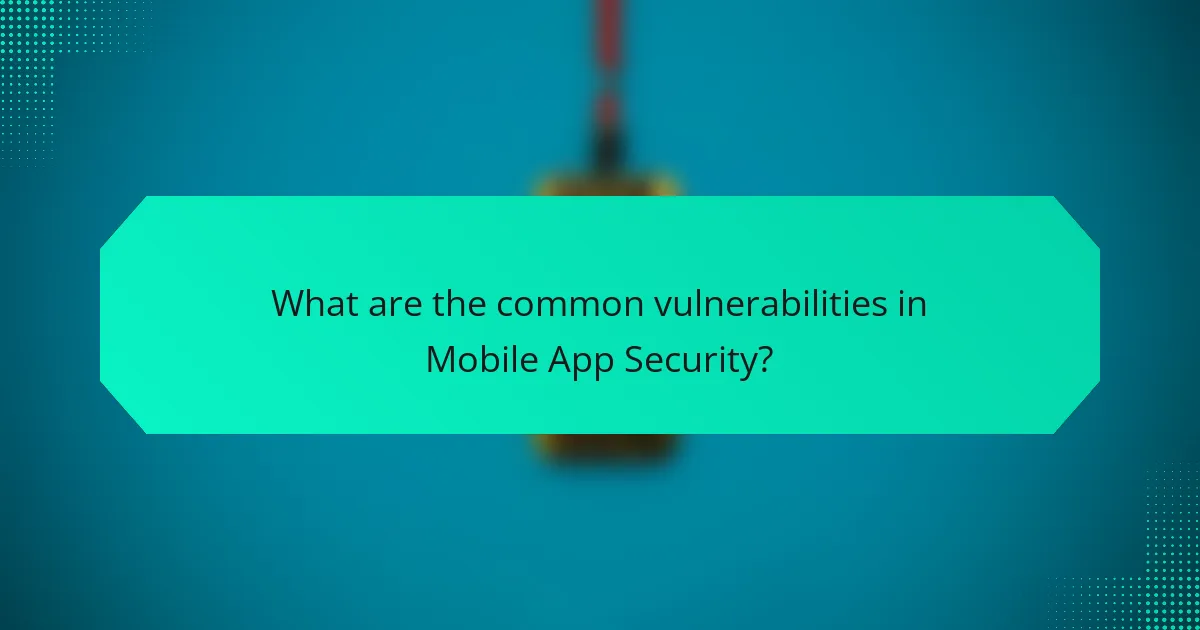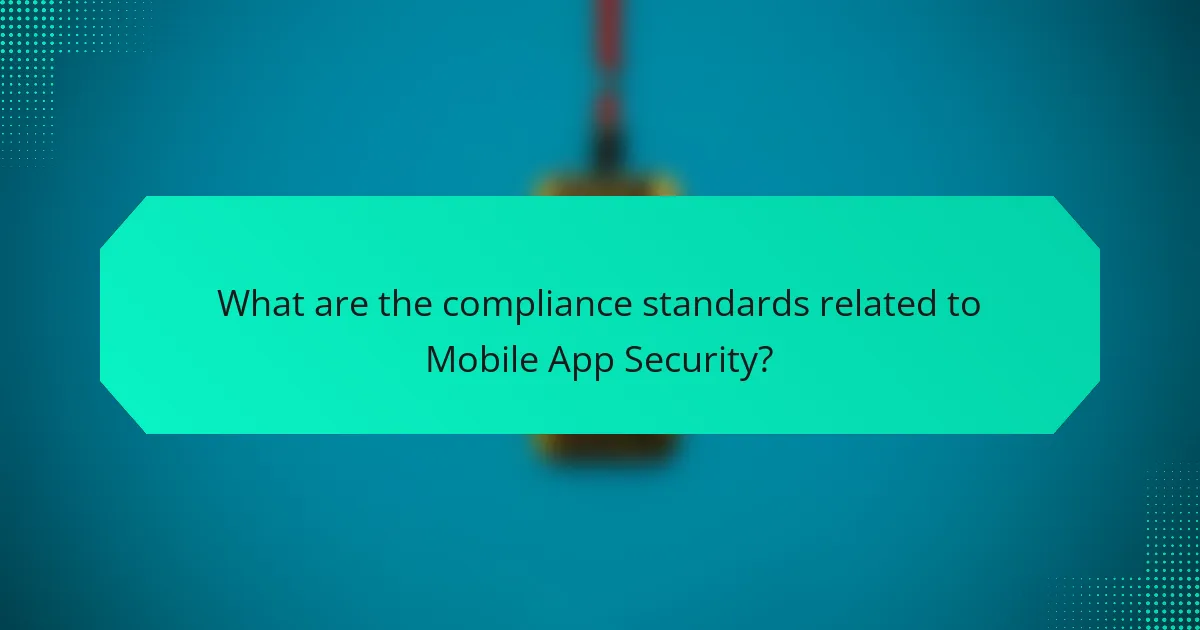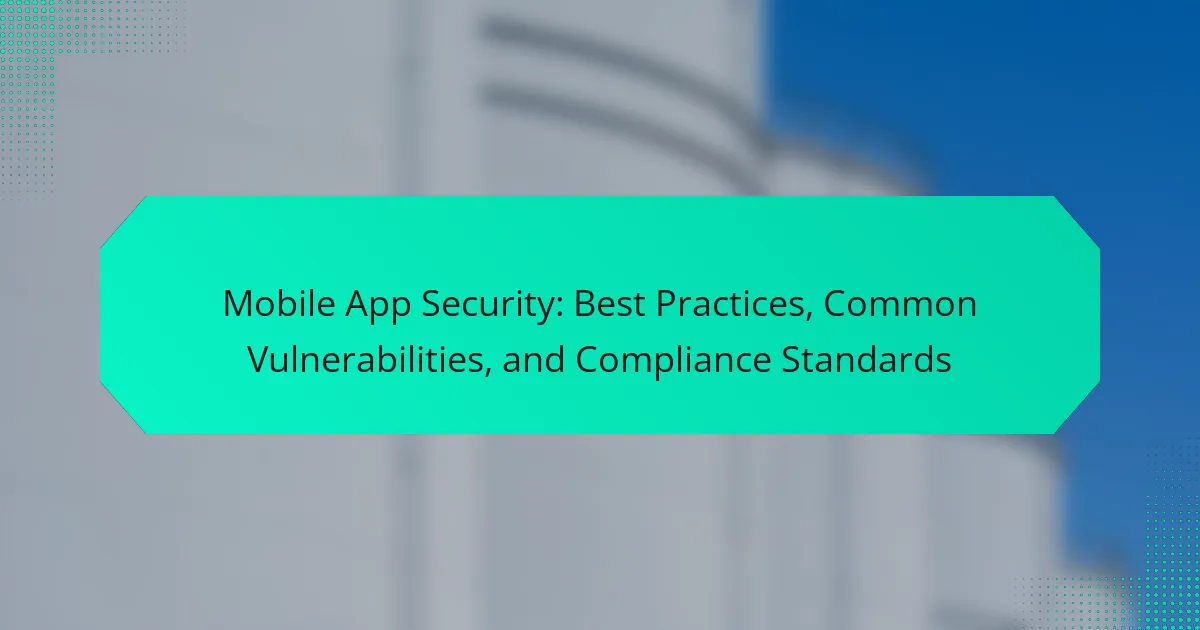Mobile app security involves the measures and practices implemented to protect mobile applications from various threats and vulnerabilities, ensuring the safety of user data and application integrity. Key aspects of mobile app security include secure coding practices, regular updates, and vulnerability assessments, as a significant percentage of mobile applications exhibit security weaknesses. Common vulnerabilities include insecure data storage, insufficient encryption, and improper authentication, which can lead to unauthorized access and data breaches. Compliance with standards such as the OWASP Mobile Security Project, PCI DSS, GDPR, and HIPAA is essential for mitigating security risks and maintaining user trust. This article outlines best practices for enhancing mobile app security, identifies prevalent vulnerabilities, and discusses relevant compliance standards.

What is Mobile App Security?
Mobile app security refers to the measures taken to protect mobile applications from threats and vulnerabilities. It encompasses a variety of practices aimed at safeguarding user data and ensuring the integrity of applications. Mobile app security includes secure coding practices, regular updates, and vulnerability assessments. According to a report by Veracode, 83% of mobile applications have at least one security vulnerability. This highlights the importance of implementing robust security protocols in mobile app development. Effective mobile app security helps prevent unauthorized access, data breaches, and other cyber threats.
Why is Mobile App Security important?
Mobile app security is important to protect sensitive user data and maintain trust. Mobile applications often handle personal information, payment details, and confidential business data. A breach can lead to identity theft, financial loss, and reputational damage. According to a 2021 report by IBM, the average cost of a data breach is $4.24 million. This highlights the financial implications of inadequate security. Moreover, regulatory compliance, such as GDPR and CCPA, mandates strict data protection measures. Non-compliance can result in hefty fines and legal consequences. Therefore, ensuring robust mobile app security is essential for safeguarding users and businesses alike.
What risks are associated with poor mobile app security?
Poor mobile app security exposes users and organizations to various risks. These risks include data breaches, where sensitive information is accessed by unauthorized parties. Such breaches can lead to identity theft and financial loss for users. Additionally, malware can be introduced through insecure apps, compromising device functionality and user privacy.
Insecure apps may also allow for unauthorized access to corporate networks, increasing the risk of corporate espionage. Regulatory non-compliance can result from poor security practices, leading to significant fines and legal consequences for organizations. Furthermore, reputational damage can occur if users lose trust in an app due to security vulnerabilities.
According to a report by IBM, the average cost of a data breach in 2021 was $4.24 million. This statistic underscores the financial implications of poor mobile app security. Overall, the risks associated with inadequate mobile app security are substantial and can have lasting impacts on individuals and businesses alike.
How does mobile app security impact user trust?
Mobile app security directly impacts user trust by ensuring the protection of personal data. When users perceive an app as secure, they are more likely to share sensitive information. A study by IBM found that 75% of consumers consider security a top factor in app usage. Conversely, security breaches can lead to significant trust erosion. For instance, 60% of users abandon apps after a security incident. Strong security measures, like encryption and regular updates, enhance user confidence. Additionally, transparent privacy policies foster trust by informing users about data handling practices. Thus, robust mobile app security is essential for maintaining and building user trust.
What are the key components of Mobile App Security?
The key components of mobile app security include data encryption, authentication, secure coding practices, and regular updates. Data encryption protects sensitive information stored on devices and transmitted over networks. Authentication ensures that only authorized users can access the app. Secure coding practices help prevent vulnerabilities during the development phase. Regular updates address security flaws and improve overall app resilience. According to the 2021 Mobile Application Security Risk Report, 80% of mobile apps have at least one vulnerability. This statistic highlights the importance of implementing these security components effectively.
What role do encryption and authentication play in mobile app security?
Encryption and authentication are critical components of mobile app security. Encryption protects sensitive data by converting it into a secure format that unauthorized users cannot access. This process ensures that even if data is intercepted, it remains unreadable without the proper decryption key. Authentication verifies the identity of users and devices accessing the app. This process prevents unauthorized access and ensures that only legitimate users can interact with the app’s features.
For instance, according to a study by the Ponemon Institute, 70% of data breaches involve unencrypted data. This statistic highlights the importance of encryption in safeguarding user information. Furthermore, implementing strong authentication methods, such as multi-factor authentication, can reduce the risk of unauthorized access by up to 99.9%, as reported by Microsoft. Thus, both encryption and authentication play vital roles in maintaining the integrity, confidentiality, and security of mobile applications.
How do secure coding practices enhance mobile app security?
Secure coding practices enhance mobile app security by reducing vulnerabilities during the development phase. These practices include input validation, proper error handling, and secure data storage. By validating user inputs, developers can prevent injection attacks, which are common in mobile applications. Proper error handling ensures that sensitive information is not exposed through error messages. Secure data storage protects user data from unauthorized access. According to the OWASP Mobile Security Project, following secure coding guidelines can significantly decrease the risk of exploitation. Implementing these practices helps create more resilient applications against potential threats.

What are the best practices for ensuring Mobile App Security?
Implementing strong mobile app security involves several best practices. First, use encryption to protect data at rest and in transit. This prevents unauthorized access to sensitive information. Second, regularly update the app to patch security vulnerabilities. Research shows that 85% of data breaches exploit known vulnerabilities. Third, employ secure coding practices to minimize risks during development. This includes input validation and proper error handling. Fourth, conduct thorough testing, including [censured] testing, to identify potential security issues. According to the OWASP Mobile Security Testing Guide, testing is crucial for uncovering vulnerabilities. Fifth, implement user authentication and authorization measures to ensure only authorized users access the app. Utilizing multi-factor authentication adds an additional layer of security. Lastly, educate users about security best practices, such as recognizing phishing attempts. User awareness can significantly reduce security risks.
How can developers implement secure coding techniques?
Developers can implement secure coding techniques by following established guidelines and best practices. They should adopt input validation to ensure only acceptable data is processed. This prevents injection attacks, a common vulnerability. Using parameterized queries is essential for database interactions. It helps mitigate SQL injection risks. Developers must also employ proper authentication and authorization mechanisms. This ensures that users have appropriate access levels. Regularly updating libraries and frameworks reduces exposure to known vulnerabilities. Conducting code reviews and security audits can identify potential weaknesses. Utilizing tools for static and dynamic analysis enhances code security. Following these practices significantly improves the security posture of mobile applications.
What are the most effective methods for input validation?
The most effective methods for input validation include whitelisting, data type checks, and length checks. Whitelisting allows only predefined acceptable values. This method minimizes the risk of invalid input. Data type checks ensure input matches expected formats, such as integers or email addresses. Length checks restrict input to a specific character range. This prevents buffer overflow attacks. Regular expressions can also be employed for complex validation patterns. Using libraries designed for input validation can enhance security. These methods collectively strengthen mobile app security against common vulnerabilities.
How can developers ensure secure data storage on mobile devices?
Developers can ensure secure data storage on mobile devices by implementing strong encryption methods. Encryption protects sensitive data both at rest and in transit. Developers should use established algorithms such as AES-256 for data encryption. They must also employ secure storage solutions like the Keychain on iOS and Keystore on Android. Regularly updating libraries and frameworks is crucial to mitigate vulnerabilities. Additionally, developers should follow data minimization principles, storing only necessary information. Implementing access controls ensures that only authorized users can access sensitive data. Finally, conducting regular security audits helps identify and rectify potential weaknesses.
What security measures should be taken during the app development lifecycle?
Security measures during the app development lifecycle include conducting threat modeling, implementing secure coding practices, and performing regular security testing. Threat modeling helps identify potential vulnerabilities early in the development process. Secure coding practices reduce the risk of common vulnerabilities, such as SQL injection and cross-site scripting. Regular security testing, including static and dynamic analysis, ensures that security flaws are detected and addressed promptly. Additionally, employing secure APIs and data encryption further protects sensitive information. Following these measures enhances overall app security and aligns with industry best practices.
How can security testing be integrated into the development process?
Security testing can be integrated into the development process through a practice known as DevSecOps. This approach incorporates security measures at every stage of the software development lifecycle. By embedding security testing in the initial phases, developers can identify vulnerabilities early. Continuous integration and continuous deployment (CI/CD) pipelines can automate security testing. Tools such as static application security testing (SAST) and dynamic application security testing (DAST) can be utilized. Regular security assessments and code reviews are essential. Additionally, training developers on secure coding practices enhances overall security. Research indicates that early integration of security can reduce vulnerabilities by up to 50%.
What tools can be used for vulnerability assessment in mobile apps?
Tools used for vulnerability assessment in mobile apps include OWASP ZAP, Burp Suite, and Veracode. OWASP ZAP is an open-source tool designed for finding vulnerabilities in web applications, including mobile apps. Burp Suite offers a range of tools for web application security testing, which can be applied to mobile applications as well. Veracode provides a cloud-based platform for application security testing, focusing on identifying vulnerabilities in mobile apps. These tools are widely recognized in the cybersecurity community for their effectiveness in assessing mobile app security.

What are the common vulnerabilities in Mobile App Security?
Common vulnerabilities in mobile app security include insecure data storage, insufficient encryption, and improper authentication. Insecure data storage can expose sensitive information to unauthorized access. Insufficient encryption may allow attackers to intercept data during transmission. Improper authentication can lead to unauthorized access to user accounts. Other vulnerabilities include code injection, insecure APIs, and insufficient logging. According to the OWASP Mobile Security Testing Guide, these issues significantly increase the risk of data breaches and exploitation.
What types of vulnerabilities are most prevalent in mobile applications?
The most prevalent vulnerabilities in mobile applications include insecure data storage, insufficient encryption, and inadequate authentication. Insecure data storage allows sensitive information to be accessed by unauthorized users. Insufficient encryption can lead to data breaches, as data transmitted over networks may not be properly protected. Inadequate authentication mechanisms can enable unauthorized access to user accounts. According to the OWASP Mobile Security Project, these vulnerabilities are common due to the rapid development cycles of mobile apps. Furthermore, the 2021 Mobile Security Report by NowSecure highlighted that 60% of mobile apps contain vulnerabilities related to data protection.
How do insecure data storage and transmission vulnerabilities occur?
Insecure data storage and transmission vulnerabilities occur due to improper handling of sensitive information. Applications may store data in unencrypted formats, making it accessible to unauthorized users. Additionally, data transmitted over insecure channels can be intercepted by attackers. Weak authentication mechanisms can also lead to unauthorized access to stored data. Poor coding practices increase the likelihood of vulnerabilities being exploited. For instance, using outdated libraries may introduce known security flaws. According to the OWASP Mobile Security Project, these vulnerabilities are common in mobile applications and can lead to significant data breaches.
What is the impact of improper session management on mobile app security?
Improper session management significantly compromises mobile app security. It can lead to unauthorized access to user accounts and sensitive information. Attackers may exploit session fixation or hijacking vulnerabilities. This can occur when session tokens are not securely generated or stored. Additionally, weak session expiration policies can allow sessions to remain active longer than necessary. According to the OWASP Mobile Security Project, poor session management is a common vulnerability in mobile applications. This highlights the need for robust session management practices to mitigate risks.
How can developers identify and mitigate these vulnerabilities?
Developers can identify and mitigate vulnerabilities through various methods. Regular security assessments, such as [censured] testing, help uncover weaknesses. Code reviews and static analysis tools can spot potential security flaws early in the development process. Keeping libraries and dependencies updated reduces exposure to known vulnerabilities. Implementing secure coding practices is essential for minimizing risks. Training developers on security awareness enhances their ability to recognize threats. Utilizing automated security tools streamlines the identification process. According to the OWASP Mobile Security Testing Guide, these practices significantly improve mobile app security.
What tools are available for vulnerability scanning in mobile apps?
Tools available for vulnerability scanning in mobile apps include OWASP ZAP, Veracode, and Checkmarx. OWASP ZAP is an open-source tool designed for finding security vulnerabilities in web applications. It supports automated scanners as well as manual testing. Veracode provides a comprehensive application security platform that includes static and dynamic analysis for mobile apps. Checkmarx focuses on static application security testing and integrates with the development process. These tools are widely recognized in the industry for their effectiveness in identifying vulnerabilities.
How can regular updates and patch management improve security?
Regular updates and patch management significantly improve security by addressing vulnerabilities in software. These updates often include fixes for security flaws that hackers exploit. For instance, the 2020 Cybersecurity Almanac reported that 60% of data breaches were linked to unpatched vulnerabilities. By applying patches, organizations can close these gaps and reduce the risk of attacks. Additionally, regular updates enhance overall system functionality and performance. They ensure that security measures are up-to-date against evolving threats. Therefore, consistent patch management is essential for maintaining a secure environment.

What are the compliance standards related to Mobile App Security?
Compliance standards related to mobile app security include several key frameworks. The OWASP Mobile Security Project provides guidelines for securing mobile applications. The Payment Card Industry Data Security Standard (PCI DSS) is critical for apps handling credit card information. The General Data Protection Regulation (GDPR) sets rules for data protection and privacy in the European Union. The Health Insurance Portability and Accountability Act (HIPAA) applies to apps managing health data in the U.S. These standards ensure mobile applications protect user data and mitigate security risks. Compliance with these frameworks can help organizations avoid legal penalties and enhance user trust.
What are the major compliance frameworks that affect mobile app security?
The major compliance frameworks that affect mobile app security include the General Data Protection Regulation (GDPR), the Health Insurance Portability and Accountability Act (HIPAA), and the Payment Card Industry Data Security Standard (PCI DSS). GDPR mandates data protection and privacy for individuals within the European Union. HIPAA sets standards for protecting sensitive patient information in the healthcare sector. PCI DSS outlines security measures for organizations that handle credit card transactions. These frameworks establish guidelines for data handling, user privacy, and security protocols. Compliance with these frameworks is essential for mobile apps to protect user data and maintain trust.
How do GDPR and CCPA influence mobile app security practices?
GDPR and CCPA significantly influence mobile app security practices by imposing strict data protection requirements. These regulations mandate that apps implement robust security measures to protect user data. GDPR requires apps to ensure data minimization and user consent for data processing. CCPA grants users rights to access, delete, and opt-out of data selling, necessitating transparent data handling practices. Compliance with these laws involves regular security assessments and updates to safeguard against breaches. Apps must also provide clear privacy policies outlining data usage. Failure to comply can result in substantial fines, emphasizing the need for rigorous security protocols.
What role does PCI DSS play in mobile payment applications?
PCI DSS ensures the security of mobile payment applications by establishing standards for protecting cardholder data. This framework mandates encryption, secure transmission, and access controls to safeguard sensitive information. Compliance with PCI DSS helps prevent data breaches and fraud in mobile transactions. According to the PCI Security Standards Council, adherence to these standards reduces the risk of data theft significantly. Mobile payment applications that follow PCI DSS guidelines demonstrate a commitment to security, fostering consumer trust.
How can businesses ensure compliance with these standards?
Businesses can ensure compliance with mobile app security standards by implementing a comprehensive security framework. This framework should include regular security assessments and audits to identify vulnerabilities. Training employees on security best practices is also essential. Establishing clear policies for data protection and access control can further enhance compliance. Utilizing secure coding practices during app development minimizes risks. Adopting industry-standard encryption methods protects sensitive data. Regularly updating software and libraries addresses potential security gaps. Finally, keeping abreast of regulatory changes ensures ongoing compliance with evolving standards.
What steps should be taken to conduct a compliance audit for mobile apps?
Identify the compliance standards relevant to the mobile app. This includes regulations like GDPR, HIPAA, or PCI-DSS. Assess the mobile app’s data handling practices against these standards. Review user consent mechanisms and data encryption methods. Evaluate third-party services used by the app for compliance. Conduct a risk assessment to identify potential vulnerabilities. Document findings and create an action plan for remediation. Finally, schedule regular audits to ensure ongoing compliance.
How can organizations stay updated on changing compliance requirements?
Organizations can stay updated on changing compliance requirements by regularly monitoring regulatory bodies and industry standards. They should subscribe to newsletters from compliance organizations. Attending industry conferences and webinars can provide insights into new regulations. Utilizing compliance management software helps track changes effectively. Engaging with legal experts ensures organizations interpret regulations correctly. Networking with peers in the industry can facilitate information sharing. Regular training sessions for staff keep everyone informed about compliance updates. These practices help organizations maintain adherence to evolving compliance standards.
What are the practical tips for enhancing Mobile App Security?
To enhance mobile app security, developers should implement several practical tips. First, use strong encryption for data storage and transmission. This protects sensitive information from unauthorized access. Second, regularly update the app to patch vulnerabilities. According to a 2022 report by IBM, 70% of data breaches exploit known vulnerabilities with unpatched software. Third, employ secure coding practices to prevent common vulnerabilities like SQL injection and cross-site scripting. Fourth, integrate multi-factor authentication to add an extra layer of security for user accounts. Research shows that this can reduce account takeover attempts significantly. Fifth, conduct regular security testing, including [censured] testing and vulnerability assessments. A study by OWASP found that proactive testing can identify up to 80% of vulnerabilities before deployment. Lastly, educate users on best practices for app security, such as avoiding public Wi-Fi for sensitive transactions. These strategies collectively enhance mobile app security effectively.
How can regular security training for developers improve app security?
Regular security training for developers enhances app security by equipping them with the knowledge to identify vulnerabilities. Developers learn about secure coding practices and common threats. This education helps prevent issues like SQL injection and cross-site scripting. Studies show that organizations with regular training see a significant reduction in security incidents. For instance, a 2020 report from the Ponemon Institute found that continuous training can decrease the average cost of a data breach by 20%. Furthermore, trained developers are more likely to implement security measures from the start. This proactive approach leads to more secure applications overall.
What are the best practices for user education on mobile app security?
Best practices for user education on mobile app security include providing clear guidelines on safe app usage. Users should be informed about the importance of downloading apps only from reputable sources. Regular updates on security features should be communicated to keep users informed. Training sessions or workshops can help users understand potential threats. Simple tips, such as enabling two-factor authentication, should be emphasized. Users should also be educated on recognizing phishing attempts and suspicious links. Providing resources for reporting security issues can empower users. Finally, using real-world examples of security breaches can illustrate the importance of vigilance.
Mobile app security refers to the measures and practices designed to protect mobile applications from various threats and vulnerabilities, ensuring user data integrity and confidentiality. The article covers the importance of mobile app security, the risks associated with poor security practices, and the key components necessary for safeguarding applications, such as encryption, authentication, and secure coding practices. It also delves into best practices for developers, common vulnerabilities found in mobile apps, and compliance standards like GDPR and PCI DSS that influence security measures. By highlighting the significance of regular updates, user education, and security testing, the article aims to provide a comprehensive understanding of how to enhance mobile app security effectively.


